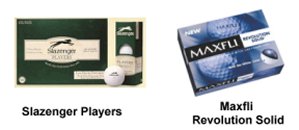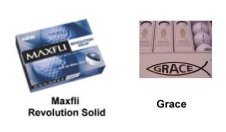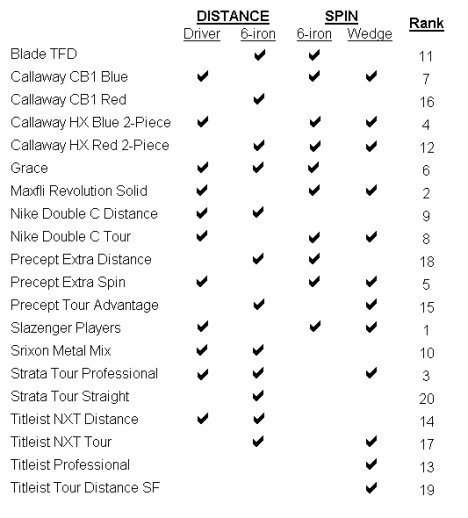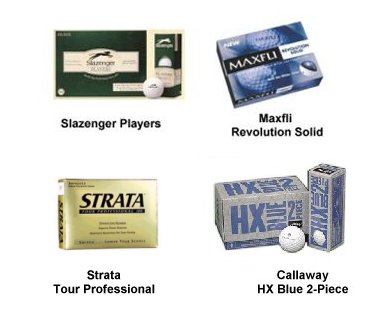
 |

|
|
2002 Golf Ball Report - Mid-Level Category In this test, we compile and examine the performance characteristics of 18 mid-level ($20-30) brand golf balls. In addition, two other golf balls (Maxfli A10, Wilson Staff True Tour) from the Premium Category test are included for benchmarking and comparison purposes. Our testing consists of three phases: Wedge Test, 6-iron Test, and Driver Test. The Wedge Test focuses primarily on initial spin rate (SPIN), the 6-iron Test deals with both distance (DIST) and spin rate (SPIN) equally, and the Driver Test concentrates mostly initial velocity (or overall distance) (DIST). Wedge Test The wedge test was performed using a Titleist DCI OS+ pitching wedge (48° loft) with a target swing speed of 65-69 mph (corresponding to roughly 80-85% of full power and a carry distance of 92-98 yards). Shots hit outside of the 65-69 mph swing speed range were re-tried. After data collection, all shot data was normalized to a 67.0 mph swing speed since spin rate increases with increasing swing speed. However, since the average swing speed for each of the 20 golf ball models was within 0.4 mph of 67.0 mph, the normalization procedure had no impact on the rankings. The data presents the trimmed averages of initial spin rate, SPIN (revolutions per minute) and launch angle, LAUNCH (degrees) for each model of golf ball. Differences of 300 RPM are deemed statistically significant. The data compiled indicates that the Slazenger Players and the Maxfli Revolution Solid were the leaders in the wedge spin rates. They were the only two balls to achieve higher wedge spin rates than the two benchmark balls (Maxfli A10, Wilson True Tour) from the Premium Category test. As expected again, the "distance" version of related ball brands exhibited lower spin rates than the "tour" or "spin" versions. However, in the case of the Callaway brand, there was a much larger disparity between the Red and Blue versions of the CB1 and HX 2-piece compared to the CTU and HX brands from the Premium Category tests. The lowest spinning ball by a large margin was the Strata Tour Straight with its special Teflon coating. This cover, according to Spalding, is specifically designed to spin less to help golfers hit the ball straighter. Nor surprisingly, this results in extremely low wedge spin rates. As in the case of the premium ball tests, balls with high spin rates also tended to have the lower initial launch angles. In fact, the low spinning Strata Tour Straight launched in the air a full 3 degrees higher than the next highest ball. Compared to the wedge test in the Premium Category, we found there was a much larger variation in the performance of Mid-Level Category golf balls. For example, in the Premium Category test, the spin rates ranged from 8240 RPM to 9240 RPM. In contrast, this test displayed a range from 5037 RPM to 9653 RPM. This is due to the inclusion of more pure "distance" balls in the Mid-Level Category price range. 
6-iron Test Testing was performed using a Mizuno Comp EZ 6-iron (31° loft) with an average swing speed of 81 mph. The Comp EZ iron was chosen due to its relatively large "sweet spot". Since the swing speed on any individual shot varied generally from 80-82 mph, the shot data were normalized to a speed of 81 mph. However, since the average swing speed for each of the 20 ball models was so close to the target speed of 81.0 mph, the normalization procedure had little impact. The data presents the trimmed averages of carry distance, DIST (yards), smash factor, SMASH (ball speed/club speed), initial spin rate SPIN (revolutions per minute), and launch angle, LAUNCH (degrees) for each model of golf ball. One thing to keep in mind is that the spin rate is the initial rate, not the final spin rate. Different balls have different spin decay rates that can alter the amount of true "bite" power when landing on the green. The data compiled indicated that there was a much wider variation in the performance with the Mid-Level Category of golf balls compared to the Premium Category golf balls. This is primarily due to the greater variety of ball types within the $20-30 Mid-Level Category (i.e., balls ranging from older "performance" balls such as the Titleist Professional to newer "distance" balls such as the Strata Tour Straight). One obervation regarding the Strata Tour Straight is due. On the Wedge Test the Tour Straight had by far the lowest spin rate. However, on the 6-iron Test it's spin rate was very close to the group average. This reaffirms the notion that the construction of the cover is most critical in determining spin rate on short shots, but on longer shots the inner construction becomes an increasingly important factor for generating spin. Golf balls that displayed the best combination of distance and spin were the Blade TDF, Grace, Precept Extra Distance, and the Callaway HX Red 2-Piece. These golf balls exhibited spin and distance rates above the category group average. As seen in previous tests, the "distance" versions of related brands did indeed go a bit farther with less spin than the "spin" versions. The one exception in this category test was the Titleist NXT Tour which out distanced the related NXT Distance. The Titleist Professional and Titleist Tour Distance SF continue to disappoint in our tests as they did in our 2001 Golf Ball Report - Irons. Both balls exhibited a less than desirable combination of less than average distance rates and only average spin rates. In contrast, one of the benchmark balls for this category, the Wilson Staff True Tour, continues to shine with above average distance and spin rates. 
Driver Test Testing was performed using two drivers: 1) a Cleveland Launcher with 10.5 degrees loft and a UST ProForce 65 R-flex shaft, and 2) a Titleist 975J with 11.5 degrees loft and a Graphite Design YS6 R-flex shaft. The two-driver system was used to mitigate any driver-specific nuances that head or shaft design can play in affecting launch conditions. A target swing speed of 94-98 mph was used to ensure consistency & accuracy from shot to shot. [Note: Swing speed measurements on the Swing Dynamics system are highly accurate, but tend to read approximately 5 mph less than more commonly used, less expensive devices.] Shots hit with speeds outside of the target range were deleted and re-tried. One other constraint was used. Drives that landed outside of the 30-yard wide "fairway" on the display (i.e. shots that were more than 15 yards offline) were deleted and re-tried. This yields a more accurate assessment of carry distance and reduces the undesired affect that a widely open or closed clubface at impact can have on the ball's flight characteristics. After all the data was collected, all shot data was normalized to a 96.0 mph swing speed since items like distance and spin rate are highly dependent on swing speed. The data represent the trimmed averages of carry distance DIST (yards), launch angle LAUNCH (degrees), initial spin rate SPIN (revolutions per minute), and smash factor SMASH (ball speed / swing speed) for each model of golf ball. Note that the carry distance does not include the amount of roll expected after the shot lands which is a complex factor between final launch angle and final spin rate, neither of which is known. Results from the driver tests yielded several observations and conclusions. First, the data showed a much higher variation from ball to ball than in the Driver Test for the Premium Category. As indicated in the 6-iron Test results this is primarily due to the greater variety of ball types included in this category (i.e., golf balls ranging from older "performance" balls such as the Titleist Professional to newer "distance" balls such as the Strata Tour Straight). In terms of overall distance, two golf balls stood out from the rest by a full yard and a half: the Maxfli Revolution Solid and the Grace. 
However, it should be strongly stated that carry distance as a yardstick for performance on driver testing can be deceiving. Take, for instance, a golf ball that has a high smash factor and thus a high rebound velocity. If the golf ball also exhibits a low spin rate that is not matched well with the tester's swing speed, then the result would be less overall distance. For example, the Blade TFD had the 3rd best smash factor but one of the lowest carry distances. This ball would perform best for a golfer with a greater swing speed than the tester as it would then produce a more optimal spin rate resulting in better carry distance. Another way the carry distance can be deceptive is that it is not measuring overall distance (carry + roll) which is more meaningful. Sometimes golf balls that carry less is due to the result of a low spinning ball (i.e., Strata Tour Straight) which would make up for its lack of carry distance with increased roll. Thus, we should also recognize, based on high smash factors, the performance of the following balls: Blade TFD and the Slazenger Players golf balls. 
Summary We believe that all of the golf balls tested in the Mid-Level Category would serve the majority of golfers quite well, as evidenced by the overall closeness of the results in an absolute sense. We attribute this mostly to how far golf ball technology has come in the past several years. To conclude our analysis of the Mid-Level Category, we identified an ideal golf ball as having a combination of high distance off the driver and 6-iron while exhibiting high spin off the 6-iron and wedge. Upon analysis of the golf balls in this category, we created the following table where a check mark indicates that the golf ball ranked above the group average for those particular criteria. 
There were no golf balls in the Mid-Level Category that exhibited above average in all four "ideal golf ball" criteria, although there were nine balls that had above average ratings in three of the four criteria. In order to further differentiate between this large group, the performance of each ball was ranked numerically in each of the four important criteria, as was done in the rankings for the Premium Category golf balls. Again, the numerical rankings are simply the performance of the ball in terms of standard deviations above the mean. The sum of the standard deviation values for all four "ideal" categories was computed. The four golf balls with the highest overall rankings were the Slazenger Players, Maxfli Revolution Solid, Strata Tour Professional, and the Callaway HX Blue 2-Piece. Based upon this analysis, Equip2Golf.com identifies these golf balls as 2002 Category Leaders for the Mid-Level Category. Interestingly, three of the four category leaders were former Premium Category golf balls that have been reduced in price as newer models are being introduced. Keep in mind, however, that this is just one test, the results were close and that most of the golf balls included in this test would work well for many golfers. 

Terms of Use |

|

©1998-2003 Equip2Golf, Inc. |